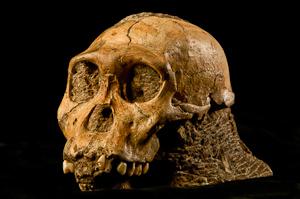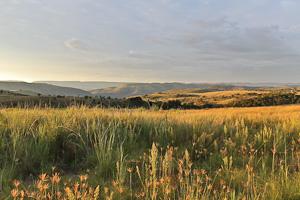

What are you currently working on?
As you may know, last year we announced [the discovery of] two partial skeletons, a male and a female, of a new species of early hominid called Australopithecus sediba. Since then, we have discovered significantly more elements to both of those individuals, particularly the female, that include several bones that we have never seen in this level of completeness or this level of lack of distortion in the early hominid species. In our new report, we discuss some of the critical morphology – that is, some of the extraordinary interpretations of the morphology that are very different from what would be expected – as well as a new date for the site, one of the most precise dates ever achieved for any paleoanthropological site anywhere in Africa, or, in fact, anywhere in the world.
I'll start from the bottom up. We're particularly working now on the foot and ankle. We have an articulated ankle of the female, as well as parts of the hilt ankle of the juvenile male. They are an incredibly surprising mix of features unexpected in an early hominid. That is, the calcaneus, which is the heel bone, is extremely primitive. In fact, it looks very similar to a chimpanzee – if we had found it in isolation, we probably would have said it was a chimpanzee.... That's incredibly surprising, given that earlier species like Lucy are more derived than this, even though they're a million years older than A. sediba. They're more like a human calcaneus. So, based on that discovery, we are going to have to re-explore things.
But more surprising is... the next little bone, which is effectively the link between the heel bone and the forefoot. It is very human-like, which indicates that sediba probably had an arched foot like a human. In fact, if you had found the two bones [of the ankle] separately, you would probably not only put them into different species but in a different genera. It's really amazing. It's going to force us to reconsider our understanding of the way in which early hominids walked, the way in which human bipedalism evolved, and the way in which the mechanics of [bipedalism] work, because this isn't working the way we thought a bipedal foot should work. In fact, it's not working like anything we've ever seen before. In addition to that, we have implications that in some ways this ankle is more primitive than forms we would have considered ancestral to this, like Lucy – A. afarensis – and maybe even more primitive than A. africanus. That's surprising because it may mean that sediba doesn't come from them, it comes from something else. Really sort of shocking to us.
We now have the female pelvis of A. sediba. It's the most complete, undistorted hemi-pelvis we have. It's undistorted down the middle, all the way around to the pubis, and the blade of the pelvis effectively looks very modern; It doesn't look an australopithecine. The pelvis is wide and flared in australopithecines, like Lucy [and others, but the A. sediba pelvis looks more curved and bowl-shaped – more modern looking. The pubis looks almost like a Neanderthal, very long and thin. But the sacrum, in the lumbar region, (the tailbone area) looks very primitive, yet it's attached to this. So we have this very primitive, almost ape-like support structure... attached to a very derived and modern pelvis.... One of the critical aspects of this pelvis, which I'll get to a little more in a moment, is that sediba has a very small brain – 420 cubic centimeters. Having this modern-shaped pelvis means that the long-held idea, the Obstetric Hypothesis – that is, enlargement of the brain and the ability to give birth to a larger brain and why the pithecan pelvis looks the way it looks – is wrong. It's been killed by the reality of the fossil record. Now we have a pelvis that is shaped like a human's, but it's not accompanied by a large brain, so we're going to have to go back to the blackboards and figure out why the human pelvis evolved the way it did. Based on this finding, it's not necessarily connected to giving birth to big-brained babies.
We also [now] have the most complete early hominid hand ever discovered – basically all of the bones except for a couple in the right hand of the female. This is extraordinary morphology because... sediba has long ape-like arms. However, the hand is not like an ape's; in fact, it looks a lot like a human hand. It has shortened fingers, and a thumb as long as a modern human's. In fact, the thumb is in the extreme upper range of a modern human's, which means it had enormous dexterity. Some people would associate that with something uniquely in our lineage, and probably with tool-making. The hand has almost no curvature in the phalanges, and in fact, remarkably, although it's 200,000 to 300,000 years older, it's more derived toward a human hand than the... hand which Homo habilis is named for.
The brain is extraordinarily small, around 422 cubic centimeters, which is right at the bottom of australopithecine variation. The interior and underside of the brain and shape of the brain are much more like a human brain than an australopithecine brain. It has bilateral symmetry and it appears to have an enlarged Broca's area. That implies that the brain is more developed than we would ever expect in a brain that small, and it means that the idea that increasing brain size came before neural reorganization is wrong, because this is showing that neural reorganization takes place, then the brain expands. That's big news.
The final paper announces a new date for the site: 1.977 million to 1.98 million years, which is unprecedented, an extraordinary discovery. That means that this [species] happened at effectively a singular moment in time. We discuss the probability that given all the derived features that appear to be associated uniquely with Homo sapiens and Neanderthals effectively, we don't know if Homo erectus was there or not, because the record's not good enough. We argue that for the time being, A. sediba should probably be considered the best candidate ancestor of the lineage leading to the genus Homo, the direct ancestor of Homo erectus, possibly to the exclusion of Homo habilis and other candidates.
So that's what I'm up to.

Well, it could have some implications for Lucy, because Lucy is actually derived in some ways toward this. However... it's too evolved for the Lucy species to have given rise to this lineage. If true, that would be amazing, because it would mean that there's a ghost lineage there.
Clearly you're very passionate about paleoanthropology, and these are fascinating discoveries. What about the study of paleoanthropology compels you the most?
We are, without a doubt, the most influential creature on this planet – in good ways and bad ways. If you want to understand anything in the natural world, you need to understand why it behaves the way it does, where it comes from, and all of the things that make it up. That's what paleoanthropology is – it's the exploration of us. It's trying to understand where we come from, what we are, and our different behavioral traits. Then we begin to understand maybe the most important animal there is to understand, because we're the problem and we're probably the solution.
Does dealing with these ancient hominids make you feel that humans today are more or less connected with nature?
I don't know if we are a part of nature. However, I think it reaffirms just how integrated we are to nature. We are a fundamental part of this planet and always have been.
Why do you think the study of paleoanthropology is relevant to today? Only because it gives us a greater understanding of where we come from?
Personally, there's just a human element to it. Do you ask your parents, "Who are my grandparents? Who are my great-grandparents? Where do I come from?" You do that because you want to understand why you're you. You want to understand why you act the way you do. You realize, intuitively, that they have something to do with your hair color, why you look the way you do, why you act the way you do, why you laugh the way you do.... You understand that there's a component of your behavior... your physiology, that is carried in your ancestry – your shallow ancestry, in this particular case – and in understanding that, you begin to understand a little bit more about the way you are and why you act the way you do. We just carry that into our deep ancestry, and for the same reason it's important for us to understand where we came from, it's also important for us to understand where we come from as a species.
In addition to paleoanthropology, you have been involved in conservation efforts, as well. Do you mind talking a little about your efforts there?
In all kinds of ways, I've always been involved in conservation issues, from when I was a kid in high school, saving endangered gopher tortoises, to... being involved in conservation issues in Africa. I was a founding trustee of the Jane Goodall Institute in South Africa and then critically involved in saving endangered and wild primates and their habitats on this continent. I've also been involved with conserving areas such as northern Kruger Park [in South Africa]... I was involved in the development of conservation programs and lodges up there that prevented poaching, etc. Throughout my life, I have been engaged in a wide variety of conservation efforts because I'm concerned with how humans are affecting this continent... and this planet.
So do you think that humans have a responsibility to save other species?
Of course we do. We have placed ourselves, probably to our detriment, as caretakers of the planet.
Photos are copyright protected and may not be reproduced without permission. Copyright information for images are as follows: 1) Lee Berger, photo courtesy of Wikimedia Commons GNU Free Documentation License; 2) A. sediba skull, photo courtesy of Wikimedia Commons GNU Free Documentation License; 3) Cradle of Humankind, photo courtesy of flowcomm and used with the permission of Flickr Creative Commons Attribution License 2.0 Generic.